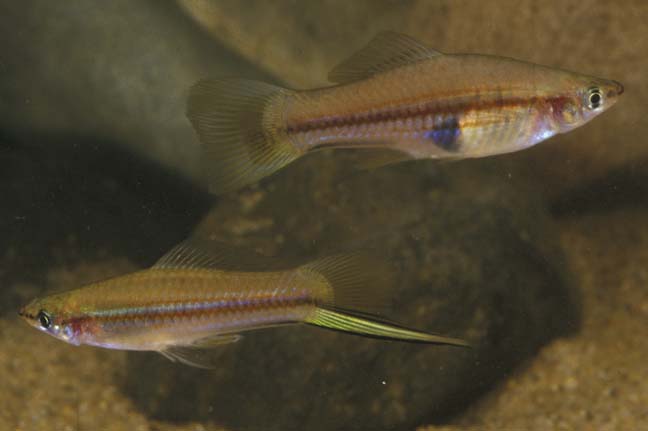Swordtail, Xiphophorus hellerii Heckel 1848

Swordtail, Xiphophorus hellerii, female above, male below. Source: Queensland Museum. License: all rights reserved
Swordtail, Xiphophorus hellerii Heckel 1848
More Info
|
Distribution |
Native to eastern Central America and introduced to Australia via the aquarium trade. Occurs in the Barron River, Cairns (16º53'S), and scattered localities along QLD coast to Burringbar Creek, northern NSW (28º26'S), also Nhulunbuy (136º47'E), Darwin (130º50'E) and Alice Springs (23º49'S, 133º44'E), NT, and recently recorded from Irwin River (29º13'S), near Geraldton, WA, and northeast of Robe, SA (37º01'S, 139º58'E). Also reported from the Todd River in central Australia in 1982, but apparently not established. A tropical species found in warm gently flowing freshwater streams with sparse vegetation over gravel substrates. Also near the edges of freshwater creeks and drains amongst aquatic plants. Can tolerate salinities up to 50% seawater. |
|
Features |
Meristic features: Dorsal fin 11-12; Anal fin 8-9; Pectoral fin 12-13; Pelvic fin 6; Gill rakers 18-20. Body moderately deep and compressed with arched back; mouth upturned and protrusible, lower jaw a little longer than upper; eyes large; gill rakers slender. Scales cover head and trunk; 26-27 in horizontal row; lateral line absent. Single dorsal fin, angular, origin about mid-body; posterior dorsal fin rays elongated in males; anal fin smaller than and situated below dorsal in females and forward of dorsal in males; anal fin modified to form gonopodium in males; caudal fin truncate, lower margin elongated in males. |
|
Size |
Females to 12 cm SL; Males to 8 cm SL. |
|
Colour |
Males bright orange overall or olive-brown to greenish with a reddish-orange stripe on sides continuing onto tail; Females orange to olive-brownish. |
|
Feeding |
Omnivorous feeding on small insects, aquatic invertebrates, algae and diatoms from weeds and substrate. |
|
Biology |
Live-bearers. The front rays of the male’s anal fin are modified to form a gonopodium which is used to internally fertilise eggs; Females are mature at 23 mm SL; greatest spawning activity from October to December with up to 9 broods per year. This species is capable of protogynous (female to male) sex change. Fertilised eggs develop inside the female. Young are born after 5-9 weeks gestation. |
|
Conservation |
|
|
Remarks |
Populations have been established in Australia since the early 1960s after deliberate or unintentional release of aquarium specimens. |
|
Similar Species |
Small females may resemble the Platy X. maculatus but the base of the tail lacks the dark blotches seen in the Platy. The sword-tail of the male is highly distinctive. |
|
Etymology |
Xiphophorus from the Greek xifos meaning sword and phero meaning carry. |
|
Species Citation |
Xiphophorus hellerii Heckel, 1848, Sitzb. K. Akad. Wissen. Wien 1: 291. Type locality: Orizaba, Mexico. |
|
Author |
Vanessa J. Thompson & Dianne J. Bray |
Swordtail, Xiphophorus hellerii Heckel 1848
References
Allen, G.R. 1989. Freshwater Fishes of Australia. Neptune, New Jersey : T.F.H. Publications pp. 1–240
Allen, G.R., Midgley, S.H. & Allen, M. 2002. Field Guide to the Freshwater Fishes of Australia. Perth : Western Australian Museum 394 pp.
Arthington, A.H. (1989) Diet of Gambusia affinis holbrooki, Xiphophorus helleri, X. maculatus and Poecilia reticulata (Pisces: Poeciliidae) in Streams of Southeastern Queensland, Australia. Asian Fisheries Science 2(2): 193-212
Arthington, A.H. & Llyod L.N. (1989) Introduced Poeciliids in Australia and New Zealand. In: Ecology and Evolution of Livebearing Fishes. Eds G.K. Meffe & F.F. Snelson. pp 333-348. Prentice Hall Englewood Cliffs NJ USA
Corfield, J., Diggles, B., Jubb, C., McDowall, R.M., Moore, A., Richards, A. & Rowe, D.K. 2008. Review of the impacts of introduced ornamental fish species that have established wild populations in Australia. Prepared for the Australian Government Department of the Environment, Water, Heritage and the Arts. 277 pp.
Dove, A.D.M. 2000. Richness patterns in the parasite communities of exotic poeciliid fishes. Parasitology 120(6): 609-623.
Hammer, M.P., Adams, M. & Foster, R. 2012. Update to the catalogue of South Australian freshwater fishes (Petromyzontida & Actinopterygii). Zootaxa 3593: 59–74.
Harris, J.H. 2013. 11. Fishes from elsewhere. pp. 259-282 in Humphries, P. & Walker, K. (eds). Ecology of Australian Freshwater Fishes. Collingwood, Victoria : CSIRO Publishing 423 pp.
Heckel, J. 1848. Eine neue Gattung von Poecilien mit rochenartigem Anklammerungs-Organe. Sitzungsberichte der Akademie der Wissenschaften in Wien 1: 289-303.
Johnson, J. 1993. Fishes of the Brisbane River. Fishes of Sahul, Journal of the Australian New Guinea Fishes Association 8(1): 347-352
Lake, J.S. (1971). Freshwater Fishes and Rivers of Australia. Melbourne : Nelson 61 pp.
Larson, H.K., Williams, R.S. & Hammer, M.P. 2013. An annotated checklist of the fishes of the Northern Territory, Australia. Zootaxa 3696(1): 1-293
Merrick, J.R. & Schmida, G.E. 1984. Australian Freshwater Fishes Biology and Management. Sydney : J.R. Merrick 409 pp. figs 280 col. figs.
Morgan, D.L. & Gill, H.S. 2001. The green swordtail Xiphophorus helleri HeckeI (Poeciliidae): another aquarium fish established in the wild in Western Australia. Records of the Western Australian Museum 20: 349-352
Rosen, D.E. & Bailey, R.M. (1963). The poeciliid fishes (Cyprinodontiformes), their structure, zoogeography and systematics. Bull. Am. Mus. Nat. Hist. 126(1): 1–176.
Unmack, P.J. 2001. Fish persistence and fluvial geomorphology in central Australia. Journal of Arid Environments 49: 653-669
Wager, R. & Unmack, P.J. 2000. Fishes of the Lake Eyre Catchment of Central Australia. Brisbane : Department of Primary Industries and Queensland Fisheries Service 88 pp.
Webb, A.C. 2007. Status of non-native freshwater fishes in tropical northern Queensland, including establishment success, rates of spread, range and introduction pathways. Journal and Proceedings of the Royal Society of New South Wales 140: 63–78.

